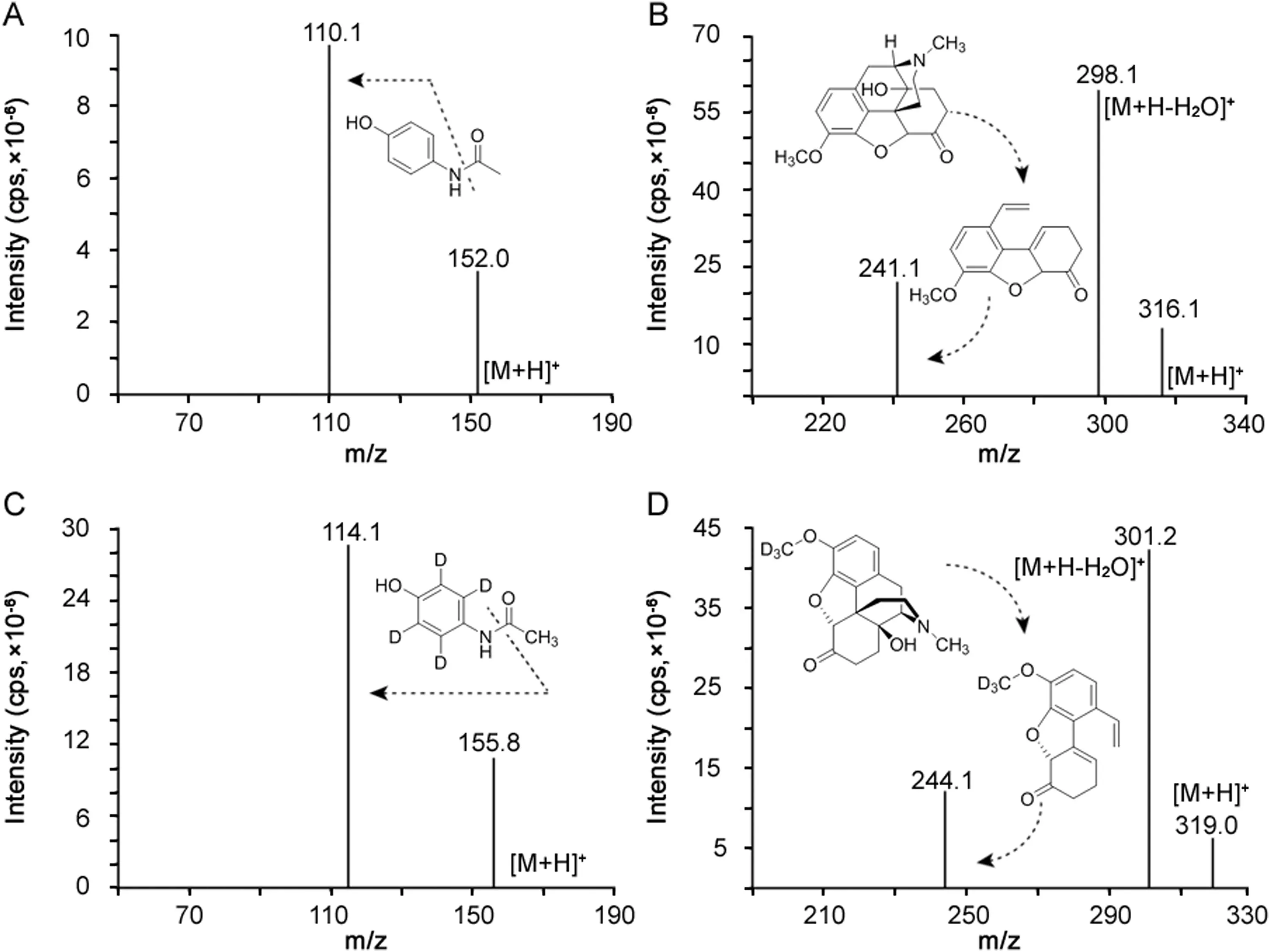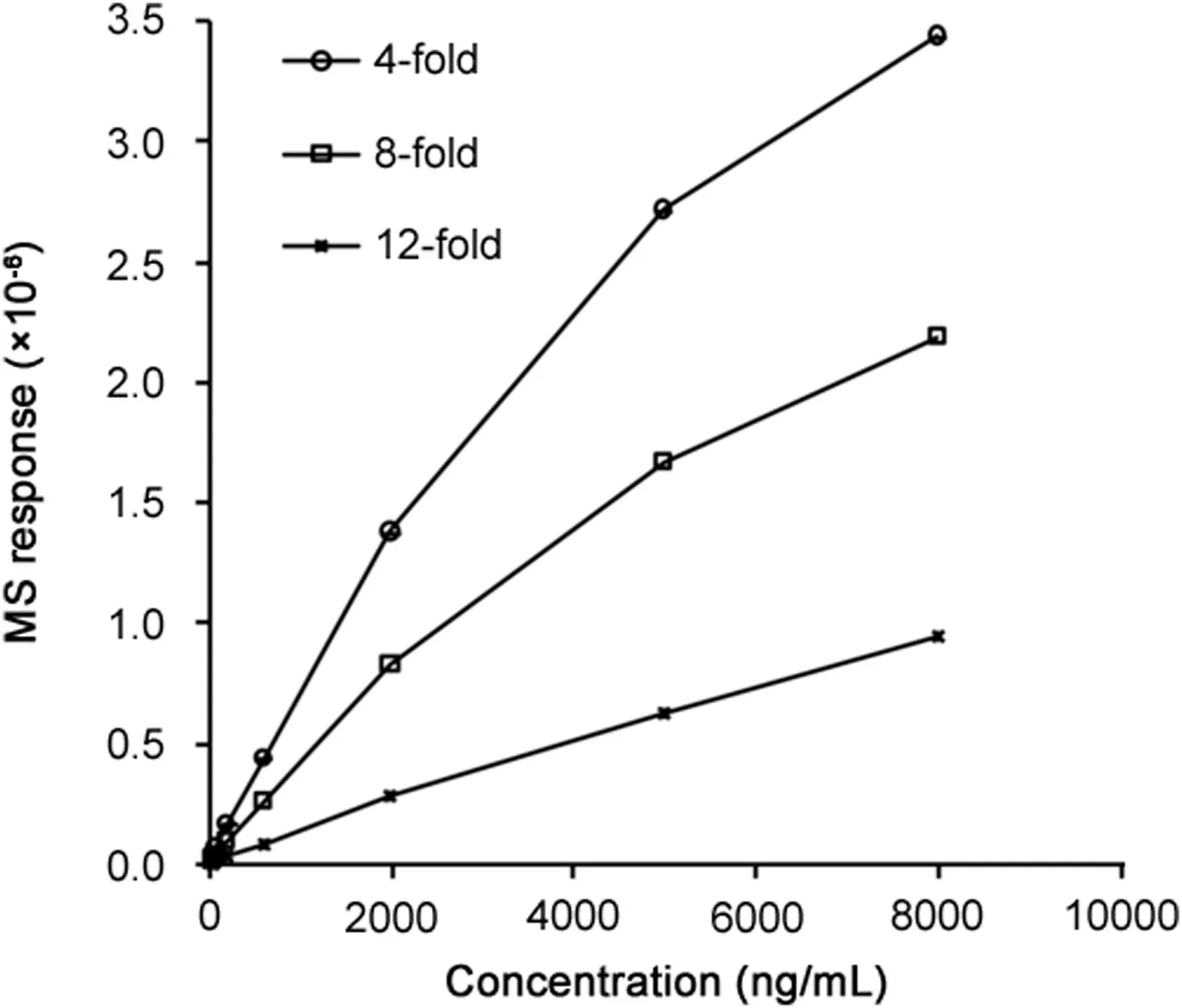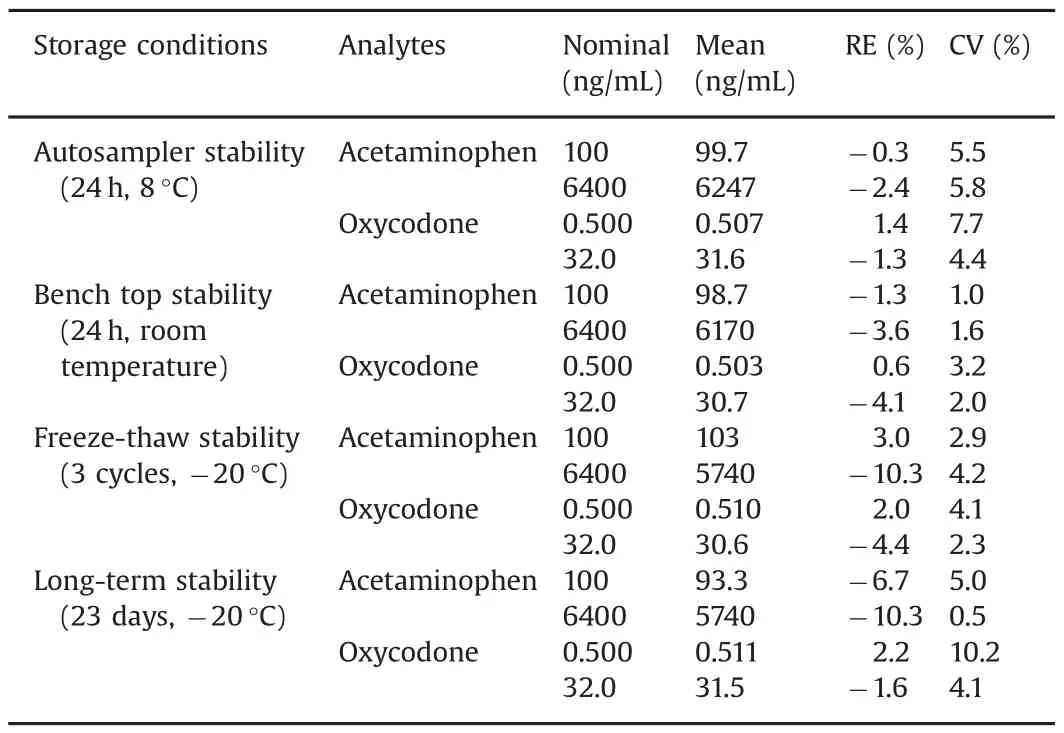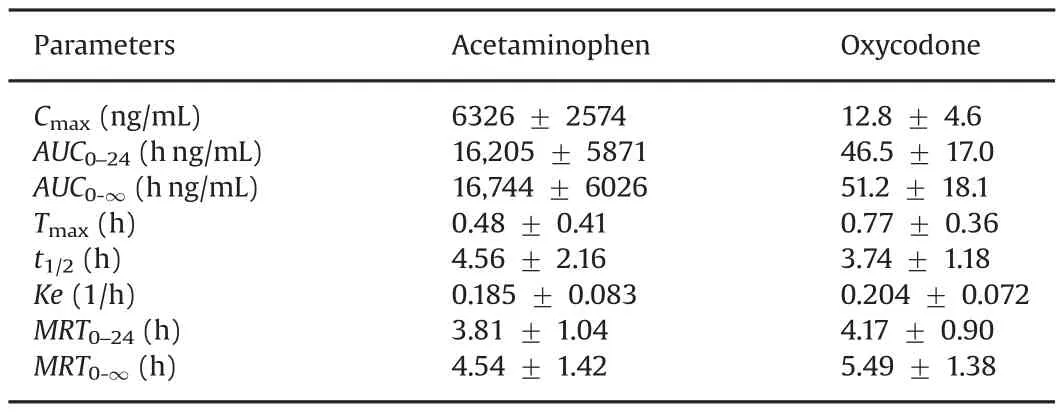Simultaneous determination of acetaminophen and oxycodone in human plasma by LC–MS/MS and its application to a pharmacokinetic study
2018-06-20WeiLuShunoZhaoMengGongLuningSunLiDing
Wei Lu,Shuno Zhao,Meng Gong,Luning Sun,Li Ding,*
aDepartment of Pharmaceutical Analysis,China Pharmaceutical University,24 Tongjiaxiang,Nanjing 210009,PR China
bNanjing Clinical Tech Laboratories Inc.,18 Zhilan Road,Jiangning District,Nanjing 211000,PR China
cResearch Division of Clinical Pharmacology,the First Affiliated Hospital,Nanjing Medical University,Nanjing 210029,PR China
1.Introduction
Acetaminophen is a frequently used analgesic and antipyretic drug worldwide.Oxycodone hydrochloride,a semi-synthetic opiate derivative of thebaine,is widely used in analgesic agents due to remarkable analgesia effect and good tolerance[1].The FDA-approved Percocet[2],combining acetaminophen with oxycodone,can be effective in pain control and help in reducing side effects and drug dependence.The commonly used dosage regimen is 325 mg and 5 mg for acetaminophen and oxycodone,respectively.The combination of acetaminophen and oxycodone provides a synergistic and opioid-sparing effect.Additionally,this combination has a safe pharmacokinetic profile,without increasing the incidence of drug addiction and acetaminophen-associated hepatotoxicity[3–7].As the abuse of prescription opioids continues to rise,measurement of acetaminophen and oxycodone in human plasma will help researchers with better drug monitoring.
Several methods have been developed for the determination of acetaminophen in biological matrix,including immunoassay[8],gas chromatography(GC)[9,10],capillary electrophoresis[11],high performance liquid chromatography(HPLC)with UV detector[12–16]or with tandem mass spectrometer[17–19].The analysis of oxycodone alone or with its major metabolites in human plasma with electrochemical detection[20,21],GC[22,23],liquid chromatography–tandem mass spectrometry(LC–MS)[24,25]and liquid chromatography–tandem mass spectrometry(LC–MS/MS)[26–37]has also been reported.Literature survey revealed that the majority of published methods determined acetaminophen and oxycodone in biological fluids individually,or in combination with other drugs[38–42].Devarakonda et al.[43]quantified acetaminophen and oxycodone in plasma with liquid-liquid extraction,but the sample preparation and method validation were not clearly described.
Simultaneous determination of acetaminophen and oxycodone in human plasma by LC–MS/MS is challenged by two problems,one is the weak retention of the analytes on traditional C18columns,and the other is that the plasma concentration of acetaminophen is much higher than that of oxycodone.The present article focuses on troubleshooting in method development,including screening of columns for better retention of the analytes,and overcoming the MS response saturation to acetaminophen while ensuring the detection sensitivity for oxycodone.Finally,the application of the validated method to a clinical pharmacokinetic study in healthy Chinese volunteers following oral administration of Percocet tablet is described.
2.Experimental
2.1.Chemicals and reagents
The reference standards of acetaminophen and acetaminophen-d4 were purchased from Toronto Research Chemicals(Toronto,Canada).The reference standards of oxycodone hydrochloride and oxycodone-d3 solution were purchased from Sigma-Aldrich Company,USA.HPLC grade methanol and acetonitrile were purchased from Merck KGaA(Darmstadt,Germany).Acetic acid and ammonium acetate were obtained from Sigma-Aldrich Company,USA.Ultrapure water was generated in house with a Milli-Q system(Millipore,Bedford,MA,USA)and was used throughout the study.Blank human plasma was obtained from healthy Chinese volunteers.All the volunteers were given informed consent.
2.2.Liquid chromatography and mass spectrometric conditions
An Exion LC system(Applied Biosystems/Sciex,USA)consisted of a binary AD pump,a vacuum degasser,an autosampler(AD multiplate sampler)and a temperature-controlled compartment for column(AD column oven).Separation of analytes was performed on a Venusil ASB C18column(2.1 mm × 50 mm,3 μm,150 A;Bonna-Agela Technologies,Tianjin,China)with a Security Guard Cartridges C18(4 mm×2.0 mm,Phenomenex,Torrance,CA,USA)maintained at 40°C.The autosampler temperature was set at 8°C.The mobile phase was composed of 2 mM ammonium acetate containing 0.1%(v/v)acetic acid(A;pH 3.6)and acetonitrile(B).The gradient elution program started at a composition of 6%B for 0.4 min,and then was ramped to 15%B at 0.5 min and held for another 1.5 min.The composition of mobile phase B was maintained at 80%from 2.1min to 2.8 min.The system returned to the initial condition at 3.0 min and held for another 1.5 min.The total run time was 4.5 min and the flow rate was constantly 0.5 mL/min.The injection volume was 5μL.
Detection of analytes and internal standards was operated on a triple quadrupole mass spectrometer,AB SCIEX Triple Quad™6500+(Applied Biosystems/Sciex,USA),equipped with an electrospray ion source in positive mode.Quantitation was performed using the multiple reaction monitoring(MRM)with a dwell time of 100 ms per transition.The MRM parameters of acetaminophen,oxycodone,acetaminophen-d4 and oxycodone-d3 are listed in Table 1.The optimized source parameters were as follows∶30 psi for curtain gas;8 psi for collision activation dissociation;650°C for turbo heater temperature;3500 V for ionspray voltage;50 psi for Gas 1;55 psi for Gas 2.Quadrupole 1 and quadrupole 3 weremaintained at unit resolution.Data processing was performed using Analyst 1.6.3 software.The fragmentation of acetaminophen(A),oxycodone(B),acetaminophen-d4(C)and oxycodone-d3(D)is given in Fig.1.

Table 1 MRM parameters of acetaminophen,oxycodone,acetaminophen-d4 and oxycodone-d3.
2.3.Preparation of stock and working solutions
Primary stock solutions for preparation of calibration standards and quality control(QC)samples were prepared from separate weighing.The standard stock solutions of acetaminophen,oxycodone and acetaminophen-d4 were prepared by dissolving accurately weighed compounds in acetontrile-water(50∶50,v/v)to give a concentration of 1.0 mg/mL.The primary standard solution of oxycodone-d3 in methanol was provided at a certified concentration of 1.0 mg/mL.The combined working solutions of analytes over the desired concentration range were prepared by further dilution of stock solutions with acetontrile-water(50∶50,v/v).A combined internal standard working solution was prepared in acetontrile-water(50∶50,v/v)at 10.0 ng/mL for oxycodone-d3 and 80.0ng/mL for acetaminophen-d4.All stock and working solutions were stored at-20°C and brought to room temperature before use.
2.4.Preparation of calibration standards and QC samples
The calibration standards and QC samples were prepared by spiking plasma with appropriate volume of respective working solutions.Calibration standards were prepared at concentrations of 40.0,80.0,200,600,2000,5000,and 8000 ng/mL for acetaminophen;0.200,0.400,1.00,3.00,10.0,25.0,and 40.0 ng/mL for oxycodone.QC samples were prepared at 40.0ng/mL(lower limitofquantification,LLOQ),100ng/mL (low QC,LQC),1200 ng/mL(middle quality control,MQC),and 6400 ng/mL(high quality control,HQC)for acetaminophen;0.200ng/mL(LLOQ),0.500 ng/mL(LQC),6.00ng/mL(MQC),and 32.0 ng/mL(HQC)for oxycodone.
2.5.Sample preparation
50μL aliquot of plasma sample was transferred to a clean 96-well plate and mixed with 25μL of internal standard working solution.The mixture was deproteinized with 200μL acetonitrile,vortex-mixed for 10min,and then centrifuged at 4000 rpm for 10 min.30μL of the supernatant was transferred to another clean 96-well plate,to which 330μL of acetontrile-water(10∶90,v/v)was added.After vortex mix for 3min,the mixture was injected into the LC-MS/MS system for analysis.
2.6.Method validation
The validation of this method was carried out following the USFDA guidelines[44].The validation included specificity,linearity,precision and accuracy,recovery,matrix effect,dilution integrity,carryover effect and stability.

Fig.1.Product ion mass spectra of(A)acetaminophen,(B)oxycodone,(C)acetaminophen-d4 and(D)oxycodone-d3 in positive mode and their proposed fragmentation patterns.
The specificity was tested for interference in the MRM channels using the proposed extraction procedure and LC–MS/MS conditions.Six batches of blank plasma obtained from six individual volunteers were analyzed and the results were compared to those obtained from samples at LLOQ.Best-fit calibration curves of peak area ratio versus analyte concentrations were drawn for acetaminophen and oxycodone.The calibration curve was fitted to a 1/x2weighed regression analysis where x is the concentration of the analyte.Precision and accuracy were evaluated at four concentration levels(LLOQ,LQC,MQC,and HQC)in six replicates.Intra-run precision and accuracy were assessments of precision and accuracy during a single analytical run.Inter-run precision and accuracy were evaluated over two days by quantification of three validation runs.Recovery experiments were performed by comparing peak area of extracted samples(spiked before extraction)to the peak area of unextracted samples(QC working solutions spiked in extracted plasma)at LQC,MQC and HQC levels.The matrix effect was assessed by comparing the peak area obtained from an amount of the analyte added in extracted blank plasma to the peak area obtained from equal concentration of the analyte in solvent.Dilution integrity was performed with six replicates each for samples spiked at concentrations of HQC and 2 times of the upper limit of quantification(ULOQ)diluted 5-fold with blank plasma.In this study,stability tests evaluated the stability of acetaminophen and oxycodone in stock solutions and plasma samples under different conditions.For stock solutions,the stability was evaluated by comparing the area response of analytes in stability samples to that of freshly prepared stock solutions.For plasma samples,bench top stability,autosampler stability,freezethaw stability and long-term stability were evaluated with three replicates each at LQC and HQC levels.
2.7.Pharmacokinetic study
Ten healthy Chinese volunteers were enrolled in the clinical pharmacokinetic study.Preliminary screening involved a medical history,physical examination,medical and laboratory evaluations.The protocol approval was obtained from a local ethics committee and informed consent was obtained from each subject.After an overnight fast of at least 10h,all subjects were administered with a single dose of one Percocet tablet(acetaminophen/oxycodone,325mg/5mg,Endo Pharmaceuticals Inc.).Blood samples were collected before drug administration(0h)and at 0.17,0.33,0.5,0.75,1,1.33,1.67,2,2.5,3,4,5,6,8,10,12 and 24h post-dosing.Whole blood was collected into heparinized tubes and centrifuged at 3000rpm for 5min.The plasma samples were stored at-20°C until analysis.The pharmacokinetic parameters were calculated with noncompartment model using WinNonlin software version 6.4.
3.Results and discussion
3.1.Method development

Fig.2.The MS response to acetaminophen obtained by using different volumes of acetontrile-water(10∶90,v/v)to dilute the supernatant of deproteinized samples.
The method development included selection of mobile phase,column types,MS detector,MS parameters and sample extraction.Acetaminophen and oxycodone are compounds with low lipophilicity and retain weakly on C18columns;thus the initial organic phase ratio should be low to achieve appropriate chromatographic separation.In the column screening stage,appropriate retention for both acetaminophen and oxycodone could not achieve on numerous C18columns,such as a Zorbax Eclipse Plus C18column(2.1mm × 50 mm,3.5 μm;Agilent Technologies),a Zorbax Extend-C18column(2.1 mm × 50 mm,3.5 μm;Agilent Technologies)and a Poroshell 120 SB-C18column(2.1 mm × 50 mm,2.7 μm;Agilent Technologies),except on an Ultimate XB-C18column(2.1mm × 100 mm,3 μm;Welch Materials,Inc.,Shanghai,China).It was observed that pure water and acetonitrile as mobile phase gave the best sensitivity and peak shape on the Ultimate XB-C18column.Tailing peak was observed when methanol was used as mobile phase B.Addition of acid in mobile phase A resulted in oxycodone eluted at dead time and addition of ammonium acetate led to unacceptable peak shapes of oxycodone.However,endogenous interference and matrix effect existed while pure water was employed as mobile phase A.A Venusil ASB C18column(2.1 mm × 50 mm,3 μm,150 Å)was then tested.The optimized mobile phase was composed of 2 mM ammonium acetate containing 0.1%(v/v)acetic acid and acetonitrile to achieve symmetrical peak shapes and better MS response.Higher concentration of ammonium acetate at 5 mM and 10 mM would inhibit MS response for all analytes.More addition of acid like 0.2%(v/v)acetic acid or 0.1%(v/v)formic acid in aqueous mobile phase would weaken the chromatographic retention of the analytes.The difference between the above two columns lies in that the Ultimate XB-C18column is a traditional reversed-phase column with endcapping while the Venusil ASB C18column is an uncapped hydrophilic column.The end-capping process might increase the lipophilicity of stationary phase,resulting in weak absorption of polar compounds.The hydrophilic column could provide better chromatographic retention and separation for strong polar compounds within a pH range of 1–5.The proportion of organic phase started at 6%to elute endogenous substance,and then increased to 15%to separate acetaminophen and oxycodone.Optimized flow rate of 0.5 mL/min helped in separation and elution of all compounds in 2 min.Whereafter,the composition of mobile phase B was set at 80%for 0.8 min to wash column and inhibit matrix effect.The elution program changed to the initial condition in order to back toward equilibrium state.
The MS-MS detection was initially performed on an API 4000 mass spectrometer(Applied Biosystems/Sciex,USA).The plasma concentration of acetaminophen was much higher than that of oxycodone after oral administration of Percocet tablet.If the analytes in plasma were not diluted,the plasma concentration of acetaminophen would be so high that the saturation of MS response to acetaminophen would result in its poor linearity of calibration curve.This means that the analytes in plasma should be diluted for determination of acetaminophen.However,if the plasma sample was massively diluted,the quantification of oxycodone at LLOQ was difficult to ensure.Even though the much higher sensitive instrument AB SCIEX Triple Quad™6500+was applied,the problems were not easily overcome without further optimization described below.
By using an AB SCIEX Triple Quad™6500+mass spectrometer,the protonated molecular ion[M+H]+was chosen as the parent ion in the Q1 full scan spectra for acetaminophen,oxycodone and the internal standards.The parent ion was used as the precursor ion to obtain the product ion in the Q3 spectra.The fragment ions with the highest relative abundance were atm/z110.1,298.1,114.1,and 301.1 for acetaminophen,oxycodone,acetaminophen-d4 and oxycodone-d3,respectively(Fig.1).Interestingly,MRM transitions atm/z316.1→241.1 for oxycodone andm/z319.0→244.1 for oxycodone-d3 showed more steady and reproducible signal intensities.Gaudette et al.[35]reported the fragmentation pattern of these transitions.The authors speculated that transitions atm/z316.1→298.1 for oxycodone andm/z319.0→301.1 for oxycodone-d3 might be the results of dehydration rearrangements.The mass-to-charge ratios of[M+H-H2O]+ions for oxycodone and oxycodone-d3 corresponded to 298.1 and 301.1.Ion source parameters and electrical parameters were optimized by monitoring the selected mass transition for the analytes.The great difference in the concentration ranges between acetaminophen and oxycodone made it challenging that both analytes in processed samples could give suitable signal intensities simultaneously via the same sample preparation.In order to avoid the MS response saturation to acetaminophen as well as guarantee the LLOQ of oxycoden detection,the analytes in plasma were diluted to a limited extent.Despite massive dilution of analytes in plasma,the MS response saturation to acetaminophen could not be avoided completely.Optimization of collision energy was also conducted to make fewer product ions of acetaminophen generated in Q3 to avoid the MS response saturation to acetaminophen.The MS condition optimization test showed that to obtain the highest intensity for acetaminophen,the collision energy of 20V should be adapted.Actually,a collision energy we wanted should inhibit the MS response saturation to acetaminophen.This meant that the collision energy should be increased appropriately to decrease the generation of the product ions of acetaminophen to an acceptable extent.Finally,the collision energy for acetaminophen was adjusted to 42V to obtain adaptive MS response.Other optimized parameters are listed in Table 1.
Previous pharmacokinetic research of drug formulations combining acetaminophen and oxycodone reported extraction of acetaminophen and oxycodone simultaneously from human plasma with liquid-liquid extraction[43].As the purpose was to develop a simple and rapid method,protein precipitation was tested.Precipitants including methanol,acetonitrile and methanol-acetontrile(1∶1,v/v)were compared.Single precipitant of acetonitrile showed higher extraction recovery and negligible matrix effect.Due to the saturation of MS response to acetaminophen at high concentration level,the volume of acetontrilewater(10∶90,v/v)used to dilute the supernatant of deproteinized samples was tested.The results of a 4-fold dilution,an 8-fold dilution and a 12-fold dilution are given in Fig.2.A 12-fold dilution,30μL of the supernatant diluted with 330μL of acetontrile-water(10∶90,v/v),showed the best linearity.The major advantage was its efficiency in simultaneous extraction of both analytes and internal standards with single step of protein precipitation.
3.2.Method validation
3.2.1.Specificity
The typical chromatograms of blank plasma,drug-free plasma spiked with both analytes at LLOQ and a clinical sample from a volunteer at 4 h after single oral administration of one Percocet tablet are shown in Fig.3.No significant endogenous interference was observed in blank plasma at the retention time of acetaminophen,oxycodone and internal standards.Potential interference of stable isotope-labeling internal standards was also evaluated in this study.The internal standards had no interference in the channel of acetaminophen and oxycodone.
3.2.2.Linearity

Table 2 Intra-run and inter-run precision and accuracy data for acetaminophen and oxycodone in human plasma.
The calibration curves showed good linearity over the concentration of 40.0–8000 ng/mL for acetaminophen and 0.200–40.0ng/mL for oxycodone.The correlation coefficient(r)of the weighed calibration curves for both analytes during the validation was≥0.995.Precision and accuracy of the back-calculated concentrations of calibration standards well met the acceptance criteria.
3.2.3.Precision and accuracy
The intra-run and inter-run precision and accuracy was summarized in Table 2.The regression equations for calibration curves were used to back-calculate the measured values of QC samples at four concentration levels.For both acetaminophen and oxycodone,the deviations of mean value from the nominal value were all within±15%and the coefficient of variation(CV)determined at each concentration level did not exceed 10.1%.
3.2.4.Recovery
Six replicates at LQC,MQC and HQC were prepared for recovery experiment.The recovery extent of each analyte and its corresponding internal standard was consistent and reproducible.The mean recovery data(with the precision)at LQC,MQC and HQC was 96.0%(7.6%),94.7%(5.0%),and 95.7%(4.5%)for acetaminophen;91.1%(5.4%),94.0%(2.4%),and 94.7%(2.3%)for oxycodone.The recovery of acetaminophen-d4 was 95.3%with the precision of 9.3%.The recovery of oxycodone-d3 was 94.1%with the precision of 2.6%.
3.2.5.Matrix effect
No significant matrix effect was observed in six batches of human plasma for both analytes at three concentration levels(low,middle and high).The matrix effects at concentrations of LQC,MQC and HQC were(96.7±6.0)%,(97.8±3.2)%,and(98.5±1.4)%for acetaminophen;(96.6±2.7)%,(98.6±1.1)%,and(97.3±1.0)%for oxycodone.The matrix effect of acetaminophen-d4 and oxycodone-d3 was(92.4±1.6)%and(98.7±1.6)%,respectively.
3.2.6.Dilution integrity
The diluted samples were prepared by a 5-fold dilution of samples at HQC and 2 times of the ULOQ with blank plasma.The determined concentrations were corrected for dilution factor.The mean back calculated concentrations for both analytes at each level were within 85%–115%of their nominal values.The maximum of CV was 6.8%.The results demonstrated that the ULOQ could be extended to 16,000 ng/mL for acetaminophen and 80.0 ng/mL for oxycodone by a 5-fold dilution with blank plasma.
3.2.7.Carryover effect
Carryover was assessed and monitored by analyzing blank plasma samples instantly following plasma samples at ULOQ.No obvious response at the retention time of analytes was observed in blank matrix samples.
3.2.8.Stability
The stock solution was found to be stable for 20 h at room temperature and 33 days at-20°C.Table 3 lists the stability ofacetaminophen and oxycodone in human plasma under different conditions.Bench top stability experiment was conducted to keep QC samples at room temperature for 24h.The freeze-thaw stability was determined over three freeze-thaw cycles.The processed samples were analyzed after being kept in autosampler at 8°C for 24h(autosampler stability).The storage time for evaluating longterm stability at-20°C was designed to be 23 days.

Table 3 Stability of acetaminophen and oxycodone in human plasma under different storage conditions.

Fig.4.Mean plasma concentration-time pro files of(A)acetaminophen and(B)oxycodone in human plasma.
3.3.Method application
The validated method was applied to quantify acetaminophen and oxycodone in human plasma samples collected from healthy Chinese volunteers after a single oral administration of one Percocet tablet.The mean plasma concentration-time pro file of acetaminophen and oxycodone is shown in Fig.4.The typical pharmacokinetic parameters are presented in Table 4.No literature revealed the pharmacokinetic pro file of acetaminophen after administration of Percocet.Gammaitoni et al.[30]only evaluated the pharmacokinetics of oxycodone following single-dose administration of Percocet at three dose levels.For the 325mg/5mg(acetaminophen/oxycodone)dose level,the reported mean values of peak plasma concentration(Cmax),area under the plasma concentration-time curve from 0h to 24h(AUC0–24),time to peak plasma concentration(Tmax)and terminal elimination half-life(t1/2)were 9.96ng/mL,48.62hng/mL,1.33h and 3.28h,respectively.AUC0–24andt1/2of oxycodone listed in Table 4 were consistent with those earlier reported values.Cmaxof oxycodone in Table 4 was slightly higher than the value in the previous study whileTmaxwas somewhat lower.This may be due to differences in race,age and genetics of the study subjects.

Table 4 Pharmacokinetic parameters of acetaminophen and oxycodone in healthy Chinese volunteers following oral administration of one Percocet tablet(mean±SD,n=10).
4.Conclusion
A simple method has been developed and validated for determination of acetaminophen and oxycodone in human plasma.To the best of our knowledge,no published methods are available for simultaneous quantification of acetaminophen and oxycodone in human plasma using protein precipitation so far.The validated method has advantages in terms of the usage of simple protein precipitation extraction and a short analysis time,which promotes high-throughput pharmacokinetic study and is useful for routine therapeutic drug monitoring.This method has been successfully applied to a pharmacokinetic study in healthy Chinese volunteers following oral administration of one Percocet tablet.
Conflicts of interest
The authors declare that there are no conflicts of interest.
[1]H.Ma,Y.Liu,L.Huang,et al.,The adverse events of oxycodone in cancerrelated pain∶a systematic review and meta-analysis of randomized controlled trials,Medicine 95(2016)∶e3341.
[2]L.R.Webster,B.Bath,R.A.Medve,Opioid formulations in development designed to curtail abuse∶who is the target?Expert Opin.Investig.Drugs 18(2009)255–263.
[3]S.Natoli,M.Lazzari,R.Carpenedo,et al.,Retrospective evaluation of a fixeddose combination of oxycodone and acetaminophen to manage moderate pain∶the lower the better,Adv.Ther.33(2016)1025–1032.
[4]B.Ward,J.M.Alexander-Williams,Paracetamol revisited∶a review of the pharmacokinetics and pharmacodynamics,Acute Pain.2(1999)139–149.
[5]S.A.Cooper,H.Precheur,D.Rauch,et al.,Evaluation of oxycodone and acetaminophen in treatment of postoperative dental pain,Oral.Surg.Oral.Med.Oral.Pathol.50(1980)496–501.
[6]J.A.Forrest,J.A.Clements,L.F.Prescott,Clinical pharmacokinetics of paracetamol,Clin.Pharmacokinet.7(1982)93–107.
[7]N.Huang,J.Zeng,J.Liang,et al.,A randomized,double-blind,placebo-controlled study of oral oxycodone plus acetaminophen for the treatment of pain in photodynamic therapy on port wine stains,Photodiagnosis Photodyn.Ther.11(2014)134–140.
[8]S.E.Halcomb,M.L.Sivilotti,A.Goklaney,et al.,Pharmacokinetic effects of diphenhydramine or oxycodone in simulated acetaminophen overdose,Acad.Emerg.Med.12(2005)169–172.
[9]A.Trettin,A.A.Zoerner,A.Bohmer,et al.,Quantification of acetaminophen(paracetamol)in human plasma and urine by stable isotope-dilution GC-MS and GC-MS/MS as penta fluorobenzyl ether derivative,J.Chromatogr.B Analyt.Technol.Biomed.Life Sci.879(2011)2274–2280.
[10]M.D.Rawlins,D.B.Henderson,A.R.Hijab,Pharmacokinetics of paracetamol(acetaminophen)after intravenous and oral administration,Eur.J.Clin.Pharmacol.11(1977)283–286.
[11]M.E.Bosch,A.J.R.Sanchez,F.S.Rojas,et al.,Determination of paracetamol∶historical evolution,J.Pharm.Biomed.Anal.42(2006)291–321.
[12]K.Allegaert,M.Y.Peeters,B.Beleyn,et al.,Paracetamol pharmacokinetics and metabolism in young women,BMC Anesthesiol.15(2015)∶163.
[13]K.Allegaert,B.J.Anderson,G.Naulaers,et al.,Intravenous paracetamol(propacetamol)pharmacokinetics in term and preterm neonates,Eur.J.Clin.Pharmacol.60(2004)191–197.
[14]O.Y.P.Hu,L.H.Pao,S.T.Ho,et al.,Pharmacokinetic properties and relative bioavailability of acetaminophen tablets,J.Med.Sci.11(1991)281–295.
[15]A.M.Rittau,A.J.McLachlan,Investigating paracetamol pharmacokinetics using venous and capillary blood and saliva sampling,J.Pharm.Pharmacol.64(2012)705–711.
[16]R.A.Langford,M.Hogg,A.R.Bjorksten,et al.,Comparative plasma and cerebrospinal fluid pharmacokinetics of paracetamol after intravenous and oral administration,Anesth.Analg.123(2016)610–615.
[17]J.Cha,B.K.Kim,M.R.Gwon,et al.,Development and validation of a UPLC-MS/MS method for the quantification of acetaminophen in human plasma and its application to pharmacokinetic studies,Transl.Clin.Pharmacol.24(2016)30–36.
[18]S.F.Cook,J.K.Roberts,S.Samiee-Zafarghandy,et al.,Population pharmacokinetics of intravenous paracetamol(acetaminophen)in preterm and term neonates∶model development and external evaluation,Clin.Pharmacokinet.55(2016)107–119.
[19]S.F.Cook,A.D.King,J.N.van den Anker,et al.,Simultaneous quantification of acetaminophen and five acetaminophen metabolites in human plasma and urine by high-performance liquid chromatography-electrospray ionizationtandem mass spectrometry∶method validation and application to a neonatal pharmacokinetic study,J.Chromatogr.B Analyt.Technol.Biomed.Life Sci.1007(2015)30–42.
[20]J.J.Schneider,E.J.Triggs,D.W.A.Bourne,et al.,Determination of oxycodone in human plasma by high-performance liquid chromatography with electrochemical detection,J.Chromatogr.B Biomed.Sci.Appl.308(1984)359–362.
[21]K.P.Leow,M.T.Smith,J.A.Watt,et al.,Comparative oxycodone pharmacokinetics in humans after intravenous,oral,and rectal administration,Ther.Drug Monit.14(1992)479–484.
[22]P.Välitalo,M.Kokki,V.P.Ranta,et al.,Maturation of oxycodone pharmacokinetics in neonates and infants∶a population pharmacokinetic model of three clinical trials,Pharm.Res.34(2017)1125–1133.
[23]B.Parodi,E.Russo,G.Caviglioli,et al.,Buccoadhesive oxycodone hydrochloride disks∶plasma pharmacokinetics in healthy volunteers and clinical study,Eur.J.Pharm.Biopharm.44(1997)137–142.
[24]M.Kokki,M.Heikkinen,P.Välitalo,et al.,Maturation of oxycodone pharmacokinetics in neonates and infants∶oxycodone and its metabolites in plasma and urine,Br.J.Clin.Pharmacol.83(2017)791–800.
[25]B.Lalovic,E.Kharasch,C.Hoffer,et al.,Pharmacokinetics and pharmacodynamics of oral oxycodone in healthy human subjects∶role of circulating active metabolites,Clin.Pharmacol.Ther.79(2006)461–479.
[26]G.T.Hao,H.Y.Zhou,H.Z.Gao,et al.,Pharmacokinetics of oxycodone hydrochloride and three of its metabolites after intravenous administration in Chinese patients with pain,Pharmacol.Rep.66(2014)153–158.
[27]T.I.Saari,H.Ihmsen,P.J.Neuvonen,et al.,Oxycodone clearance is markedly reduced with advancing age∶a population pharmacokinetic study,Br.J.Anaesth.108(2012)491–498.
[28]M.Neuvonen,P.J.Neuvonen,Determination of oxycodone,noroxycodone,oxymorphone,and noroxymorphone in human plasma by liquid chromatography-electrospray-tandem mass spectrometry,Ther.Drug Monit.30(2008)333–340.
[29]W.B.Fang,M.R.Lofwall,S.L.Walsh,et al.,Determination of oxycodone,noroxycodone and oxymorphone by high-performance liquid chromatography–electrospray ionization-tandem mass spectrometry in human matrices∶in vivo and in vitro applications,J.Anal.Toxicol.37(2013)337–344.
[30]A.R.Gammaitoni,M.W.Davis,Comparison of the pharmacokinetics of oxycodone administered in three Percocet formulations,J.Clin.Pharmacol.42(2002)192–197.
[31]J.Hardy,R.Norris,H.Anderson,et al.,Is saliva a valid substitute for plasma in pharmacokinetic studies of oxycodone and its metabolites in patients with cancer?Support.Care Cancer 20(2012)767–772.
[32]J.Malone,L.Hughes,An HPLC-MS/MS method for the determination of oxycodone,noroxycodone&oxymorphone in human plasma,Almac Sciences(2014),http∶//dx.doi.org/10.13140/RG.2.1.5059.0242.
[33]M.Dawson,B.Fryirs,T.Kelly,et al.,A rapid and sensitive high-performance liquid chromatography-electrospray ionization-triple quadrupole mass spectrometry method for the quantitation of oxycodone in human plasma,J.Chromatogr.Sci.40(2002)40–44.
[34]A.E.Olesen,R.Upton,D.J.R.Foster,et al.,A pharmacokinetic and pharmacodynamic study of oral oxycodone in a human experimental pain model of hyperalgesia,Clin.Pharmacokinet.49(2010)817–827.
[35]F.Gaudette,A.Sirhan-Daneau,M.St-Onge,et al.,Development of a sensitive method for the determination of oxycodone and its major metabolites noroxycodone and oxymorphone in human plasma by liquid chromatographytandem mass spectrometry,J.Chromatogr.B 1008(2016)174–180.
[36]M.Wagner,E.Bourgogne,E.Varesio,et al.,Quantitation of polar analytes using column-switching∶application to oxycodone and three metabolites in human plasma,J.Chromatogr.B 878(2010)637–644.
[37]F.Pantano,S.Brauneis,A.Forneris,et al.,Determination of oxycodone and its major metabolites noroxycodone and oxymorphone by ultra-high-performance liquid chromatography tandem mass spectrometry in plasma and urine∶application to real cases,Clin.Chem.Lab.Med.(2017),http∶//dx.doi.org/10.1515/cclm-2016-0990.
[38]T.Dahn,J.Gunn,S.Kriger,et al.,Quantitation of morphine,codeine,hydrocodone,hydromorphone,oxycodone,oxymorphone,and 6-monoacetylmorphine(6-MAM)in urine,blood,serum,or plasma using liquid chromatography with tandem mass spectrometry detection,Methods Mol.Biol.603(2010)411–422.
[39]X.Qiu,D.Lou,D.Su,et al.,Simultaneous determination of acetaminophen and dihydrocodeine in human plasma by UPLC-MS/MS∶its pharmacokinetic application,J.Chromatogr.B 992(2015)91–95.
[40]R.Coles,M.M.Kushnir,G.J.Nelson,et al.,Simultaneous determination of codeine,morphine,hydrocodone,hydromorphone,oxycodone,and 6-acetylmorphine in urine,serum,plasma,whole blood,and meconium by LC-MSMS,J.Anal.Toxicol.31(2007)1–14.
[41]H.C.Atkinson,I.Stanescu,C.Frampton,et al.,Pharmacokinetics and bioavailability of a fixed-dose combination of ibuprofen and paracetamol after intravenous and oral administration,Clin.Drug Investig.35(2015)625–632.
[42]T.Zhu,L.Ding,X.Guo,et al.,Simultaneous determination of tramadol and acetaminophen in human plasma by LC–ESI–MS,Chromatographia 66(2007)171–178.
[43]K.Devarakonda,T.Morton,R.Margulis,et al.,Pharmacokinetics and bioavailability of oxycodone and acetaminophen following single-dose administration of MNK-795,a dual-layer biphasic IR/ER combination formulation,under fed and fasted conditions,Drug Des.Dev.Ther.8(2014)1125–1134.
[44]Guidance for Industry,Bioanalytical Method Validation,U.S.Department of Health and Human Services,Food and Drug Administration Centre for Drug Evaluation and Research(CDER),Centre for Veterinary Medicine(CVM),May,2001.
杂志排行
Journal of Pharmaceutical Analysis的其它文章
- Overview of the detection methods for equilibrium dissociation constant KDof drug-receptor interaction
- Quantification and pharmacokinetic study of tumor-targeting agent MHI148-clorgyline amide in mouse plasma using liquid chromatography-electrospray ionization tandem mass spectrometry
- Evaluation of physicochemical properties as supporting information on quality control of raw materials and veterinary pharmaceutical formulations
- Identi fication of three kinds of Plumeria flowers by DNA barcoding and HPLC specific chromatogram
- Enhancing the dissolution of phenylbutazone using Syloid®based mesoporous silicas for oral equine applications
- Enrichment and immobilization of macromolecular analytes on a porous membrane utilizing permeation drag
